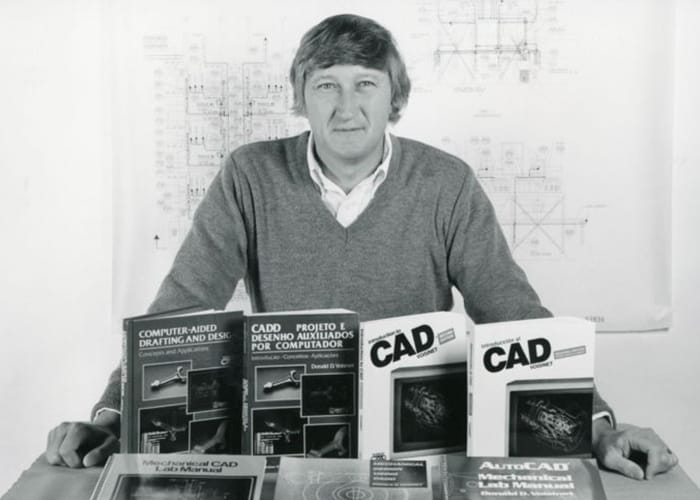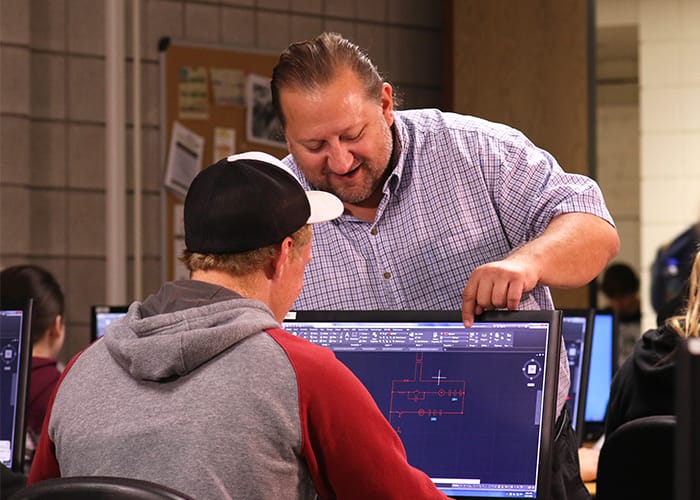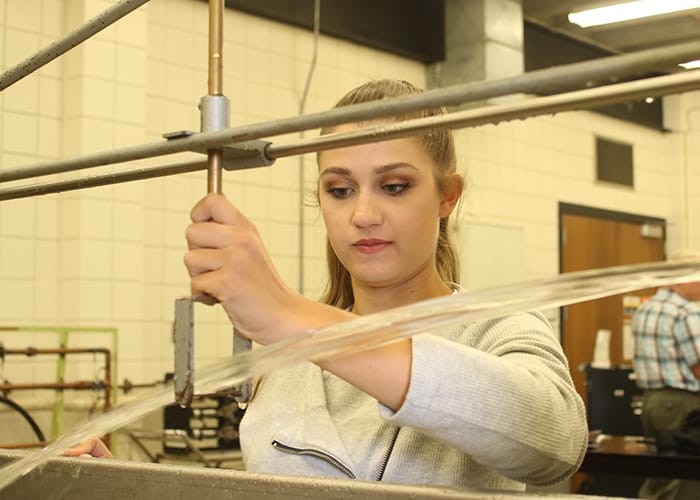- Home
- /
- Private: 2018-19 Annual Report
- /
- Annual Report 2017-18
- /
- Three Generations of Engineers
Three Generations of Engineers
By Denyel Beiter, ’07
The Voisinet family share more than DNA. They share a passion for engineering, design, and drafting. The three generations of engineers include Don (grandfather), Mark (father), and Brigette (daughter). They have gone from T-square to software in the classroom and nearly 50 years after Don began teaching at SUNY Niagara, the three continue to exhibit their talents in engineering throughout the Western New York community and beyond.
Prior to teaching at SUNY Niagara’s “Nabisco Tech” campus in Niagara Falls, Don graduated from the University at Buffalo and worked at General Motors’ Tonawanda plant designing patterns for the 396 Engine. In 1969, he became an Assistant Professor at SUNY Niagara. Two years later, he founded the Design and Drafting program. It did not take long before this track became a major success for students, achieving near 100% job placement for graduates.
Under Don’s leadership as Program Coordinator, he saw the future of design and drafting was going to be fully automated after he discovered some of the first CADD software. With the introduction of this tool in the early 1980’s, Don recognized that the usage of pencils, mylar, triangles, compasses, and perfect hand-written lettering would slowly come to an end. Don realized, “This [software] is the wave of the future. This is something that will make a difference.” He studied, researched, and soon found out he was ahead of the curve. Being involved with the inception of Computer Aided Drafting and Design software quickly catapulted him into a pioneer role in this new electronic version of engineering. He wrote some of the very first CADD textbooks and traveled the United States training thousands of college instructors and engineering firms on ways to incorporate the new found tools into their work. Don, a change agent and student advocate, also wrote grants and was able to procure many donations such as computers and software in order to train students on the latest technologies the industry would be using.

Don Voisinet

Mark Voisinet, ‘87
Don’s son, Mark, a 1987 SUNY Niagara alumnus of the Design and Drafting program, now spearheads the Department as the Program Coordinator. His career path was launched upon graduating from SUNY Niagara when he worked on local engineering projects for major companies like Harrison Radiator (Delphi), Calspan, Praxair, Dupont, and Wilson Greatbatch. He also went on to earn a Bachelor’s degree in Applied Engineering from the Rochester Institute of Technology (RIT) and a Master’s of Science degree in Industrial Technology from SUNY Buffalo State.
His knowledge in design and drafting is only met by his passion for students. He continues in his father’s footsteps, helping graduates achieve near 100% job placement. “We teach our students real skill sets that are highly marketable and hirable. I regularly meet with local industry leaders in order for the program to stay cutting edge. On my watch, I want to stay true to the community college mission and serve our students. I also want to produce great leaders for the industry and make sure we have a program that is meeting the needs of local business.” With so many job openings in the engineering field throughout Western New York, Mark reports phone call after phone call from companies looking for graduates who are ready to enter the workforce.
“Our alumni are now leaders in the industry. We have CEOs, presidents, vice presidents, general managers, and project managers who have gone through our CADD program. Many graduates stay in the area because there are so many jobs.” Mark also reports that some students do decide to move, though. “Earning a State University of New York (SUNY) degree holds a lot of weight,” and some students follow job offers which take them around the country to places like NASA and SpaceX.
Mark also has his eyes set on the future of industry, just like Don did. He has been able to acquire three-dimensional (3D) printers and scanners, create a 3D lab, write a textbook, and train students in both design and drafting using the latest CADD software. “SUNY Niagara has a premiere program where students are trained how to design in addition to drafting. We give students a foundation which teaches them the ‘what’ and ‘why’ of design, we teach the engineering formulas and how to apply them, and we teach them how to design. They will leave the program knowing how to read and create project plans. Industry managers are able to trust our graduates with design work.” Mark went on to explain that the A.A.S. degree in CADD allows students to specialize in piping, architecture, civil design, electrical design or mechanical design. Furthermore, graduates could also work in procurement, sales, materials, and management because of the required classes in college writing and other liberal arts classes. Some even go on to become technology teachers and college professors. These courses compliment hands on experiences which create transferability and hire ability.
Mark’s own daughter, Brigette, is the most recent Voisinet to step through the CADD program. She graduated in 2017 and is an example of the curriculum’s transferability and attainment. “After graduating, I transferred to Buffalo State College where I am now studying to earn my Bachelor’s degree in Mechanical Engineering.” Brigette now holds a secure internship at a local aerospace manufacturing company which she began while she was at SUNY Niagara.
“I loved my time at SUNY Niagara. I liked how the teachers got to know me and invested in what I was doing; they wanted me to succeed. I liked the professors who worked in the industry and knew exactly what I needed to know. Processes class was fun because our instructor was so excited and involved. The Mechanical Technology Design classes with my dad were great, too.
When asked what it was like taking classes from her dad, Brigette explained, “In the classroom, my dad kept it very professional; it was a professor-student relationship. I was never given special attention and it was all very equal. He would tell me, ‘Do your work and do it well.’ He told me stories about how my grandpa was like that with him. I always worked hard to make my dad proud.”

Brigette Voisinet, ‘17
In correlation with her studies, Brigette has also found her voice within the engineering field as a women’s advocate. She is often invited to her former all-girls high school to speak as a panelist about her experience in engineering. “In many of my college classes, I am the only girl. If you eliminate half of the population thinking they have no interest [in engineering], you are already decreasing the workforce. We need to get girls in this high paying field.
After finishing her schooling and gaining experience in the mechanical engineering industry, Brigette hopes to teach at SUNY Niagara in the future. If SUNY Niagara’s proposed $30 million STEM building can be constructed, she could be carrying her family’s torch through the next wave of engineering trends in the College’s brand new state-of-the-art facilities and laboratories.
“At the end of the day, it is about student outcomes. We are so proud when a student has accepted a job, especially within the region,” declares Mark. The new facilities, labs, and equipment will match the unrivaled educated graduates receive from SUNY Niagara.
To learn more about SUNY Niagara’s Computer Aided Drafting and Design program or the potential STEM building, please visit www.niagaracc.suny.edu/programs/cadd/.

